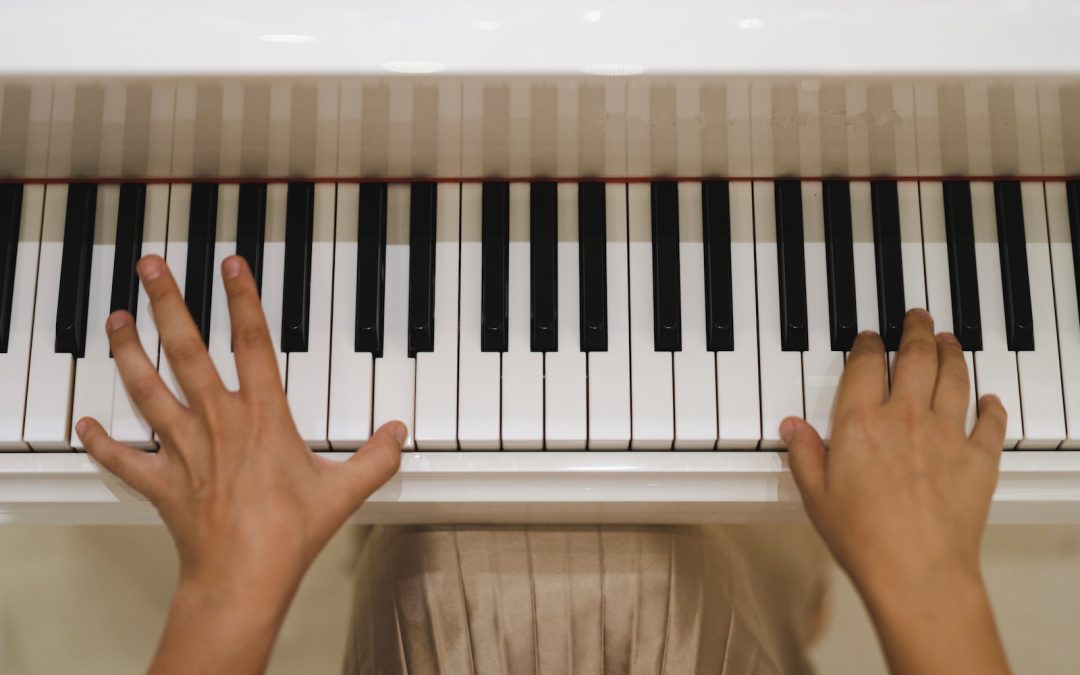Just like you, I'm a beginner piano player who's recently run into something called piano chord inversions. It's a term that might sound intimidating, but trust me, it's a concept that's not only essential but also quite fascinating.
In our piano lessons, we learn that a chord is a group of notes played simultaneously. The most common ones we encounter are triads, which are 3-note chords. But what happens when we shuffle these notes around? That's where chord inversions come into play.
What are piano chord inversions?
When you're learning to play piano, understanding and mastering piano chord inversions can truly ramp up the repertoire you can play. Let's delve a bit further into what these inversions are.
Piano chord inversions are simply chords played with the notes shuffled in a different order. If you have a basic understanding of chords, you know that they're groups of notes played simultaneously, often consisting of triads (three-note chords). Switching the order of these notes gives us the so-called inversions.
Consider this: there's more than one way to play any given chord. For instance, the inversion exercise for piano in C Major doesn't look or sound the same as the same chord in B Major. Practicing chord inversions not only makes your playing more versatile but it also enhances your ear's ability to recognize distinct chordal patterns.
It might sound intimidating at first but let me assure you, investing time in understanding inversions helps you navigate the keyboard more naturally. You'll encounter these patterns repeatedly in most piano pieces, so mastering them will prove extremely beneficial.
Instead of sticking to one chord in its root form, I encourage you to explore altered chord voicings with inversions. You will find that this strategic exercise can help you master essential chord inversions - and quicker than you think. We're talking weeks instead of years. Sounds exciting, right?
Let's proceed to our next section where we'll learn how to easily identify and create various chord inversions, and what fingering is best to use. There's a lot to grasp here, but don't worry, we'll take it one step at a time. Can hardly wait to move forward in this inversions journey!
Why are chord inversions important for beginners?
When first learning to play chords on a piano, most people begin with what's known as the root position. With a C chord, for example, you'd learn the chord in the sequence of the notes C, E, and G. Sounds simple, right? But here's the twist: understanding piano chord inversions allows musicians to play these same notes in a different order, providing versatility and a depth of sound that lays the foundation for a broad range of music styles.
So, why are these inversions so important to beginners, you might ask? Well, by learning to play chords in different but standard positions, beginners can transition smoothly from basic to more complex chords. They become aware of patterns and variations in music that would be tough to isolate without these inversions. This gained versatility opens broader horizons of musical creativity.
Another crucial thing to master regarding inversions is the ideal fingering technique. The fingering '1-2-5' or '1-3-5' is not arbitrary. The selection depends on the distance of the note adjacent to the pinky.
| Fingering | Right Hand | Left Hand |
|---|---|---|
| 1-2-5 | First Inversion Chord Shape | Second Inversion Chord Shape |
| 1-3-5 | Any time the note adjacent to the pinky is a third interval | Whenever the note next to the pinky is a third interval |
To summarize, if the note next to the pinky is a third interval, the '1-3-5' fingering should be used. '1-2-5' is more suitable when the interval is a fourth ‒ to allow for the larger distance.
How to identify chord inversions on a piano?
Learning how to identify chord inversions on the piano can initially feel slow and cumbersome, often involving a painstaking process of figuring out each note as you go. However, rest assured, with practice, these patterns will become ingrained in your musical vocabulary. You'll be able to see a pattern of notes on a staff, and instantly recognize the chord and its inversion. One recommended practice tool for this skill is using sheet music.
Reading sheet music can drastically improve your sight-reading abilities, as well as your capacity to quickly recognize chords and their inversions. As you analyze the notes and pay attention to the chord formation's appearance on paper, the patterns will start to materialize. Between the lines and spaces, you'll begin spotting the clusters that signal different chord inversions.
Let's further understand how you can arrange the notes in a chord, which leads us to the concept of chord inversions. For instance, if you play a triad (three notes), that chord can have three inversions. In the case of a four-note chord, there will be four chord inversions, and so on. Through the table below, let's visualize this concept:
| Number of Notes in Chord | Number of Chord Inversions |
|---|---|
| 3 | 3 |
| 4 | 4 |
| 5 | 5 |
The beauty of piano chord inversions is their ability to help you play the piano in a flowing manner, without making the music sound choppy. They allow for freedom in hand movement, reducing the necessity to stick with the root position for each chord. These inversions contribute to the dynamic versatility of minor or major chords, also known as triad chords. Eventually, with consistent practice and exposure to various chord progressions, this process will come naturally to you. You'll see a chord inversion without having to think about it.
Remember, mastering the art of piano chord inversions requires patience and consistency. So, don't rush. Instead, embrace the learning process and let the music flow naturally. You'll find the path from a basic beginner to an experienced musician unfolding naturally as your understanding deepens.
Understanding the different types of chord inversions
That's right, even though we're dealing with the same notes, chord inversions alter the way chords sound, and the difference can be striking. For instance, in the iconic song "God Only Knows" by The Beach Boys, the use of inverted chords lends a unique tension and mood - an effect that regular chords simply couldn't deliver.
Let's dive a bit deeper. Picture a simple C major chord, made up of C, E, and G. In its root position, C sits at the base of our chord. But what if we shuffled things around, put G at the bass? Voila - you're now looking at a C major chord inversion.
Remember: A chord inversion occurs when any note other than the root note is placed at the bass.
If we break it down, there are two fundamental types of inversions relevant to the root, third, and fifth notes in major, minor, and diminished chords.
Firstly, the Root Position, where the name-giving root note anchors the chord. Secondly, the 1st Inversion, where the third note assumes the role of the bass. And finally, we have the 2nd Inversion, which pushes the fifth to the forefront, sandwiching the other notes in between.
Here's a handy trick: next time you're experimenting with some chords, try out these movements - Root Position, 2nd Inversion, 1st Inversion, and again Root Position.
These sequences aren't the only ones possible, but are quite common. It's all about exploration, after all.
There aren't any stringent rules to follow, but a few tips can enhance your play. To put it simply, piano chord inversions allow you to arrange notes in a variety of ways, providing you the freedom to create harmonious music while maintaining a smooth flow.
If you dive into more complex chords, the number of inversions will rise. For instance, four-note chords offer four inversions. Five-note ones? Five inversions.
At the heart of mastering this technique is a simple mantra: patience and consistency. Brace yourself for myriad harmonic adventures as you experiment and familiarize yourself with how these variations affect your music.
Practice exercises for learning piano chord inversions
Consistent practice is undeniably crucial after understanding the theory behind piano chord inversions. I'd like to share a few methods that can significantly enhance your inversion practice regime. Try dedicating 5-15 minutes of your session to any of these exercises and don't forget that correct fingering is essential when forming these chords and inversions.
We'll start off with a simple exercise that works wonders in developing the muscle memory for the chord you're practicing. First, select any chord. For example, consider 'C Major'.
- Play this chord in root position
- Move onwards to play the same chord in the first inversion
- Next, play the chord in second inversion
- Repeat these steps while moving upwards on the piano for an octave or two
- Finally, move back down the piano back to your initial position
This drill could potentially hasten your journey to mastering chord inversions.
But remember, with a myriad of chord and inversion possibilities, finding an approach to practice can seem daunting. This is when the circle of fifths comes into play. The beauty of this concept is its adherence to most music that move in perfect fourth and perfect fifth intervals. Practicing this way aids in internalizing how music operates.
Knowing the notes in a chord and their location on the piano is useful but memorizing and intuitively knowing where to find them is a game-changer.
Before wrapping up this section, let's not forget an innovative piece of practice - the 21 Inversion Exercise. As the name suggests, this exercise ingeniously cycles through 21 chord inversions drawn from the major scale. This acts as a natural extension of major scale studies for late beginner and early intermediate students. This exercise could potentially revolutionize your inversion practice sessions. Always remember, mastering chord inversions requires patience and tenacity.
Remember, journeying down the inversions lane not only sharpens your technique but also broadens your stylistic range. Armed with these exercises, you're ready to delve deeper into the realm of chords and their inversions.
Conclusion
Mastering piano chord inversions is a journey, not a sprint. As we've seen, they're crucial for smooth transitions, pattern recognition, and broadening your musical style. Perfecting your fingering technique is key, and the exercises we've discussed, such as the 21 Inversion Exercise and the circle of fifths, are practical tools to help you get there. Remember, it's about developing muscle memory and understanding how music operates. So don't get discouraged if you're not getting it right away. Keep practicing, stay patient, and your tenacity will pay off. As you continue to learn and grow, you'll find that chord inversions add a new depth and versatility to your piano playing.
Harlan Kilstein began playing piano during covid with no piano background at all. He taught himself how to play learning what to do and what not to do.
Today he's an advanced intermediate player and can help you grow in your skills because he learned all this on his own.








